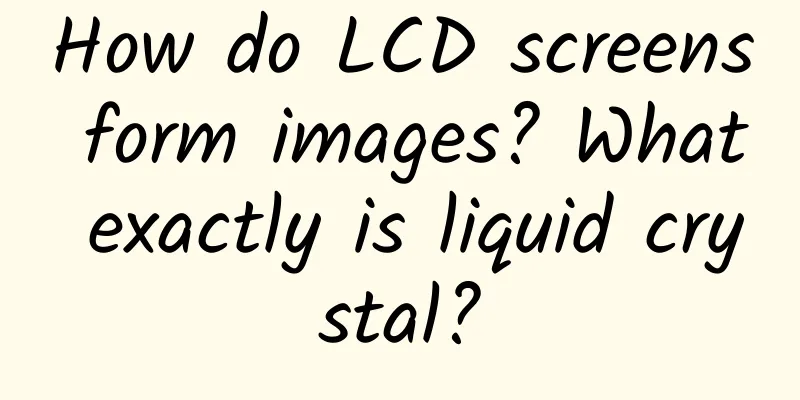How do LCD screens form images? What exactly is liquid crystal?

|
Produced by: Science Popularization China Author: Wang Zhihao Producer: China Science Expo From bulky monitors and plasma TVs to the emerging laser TVs, there are many members in the display family. Many of these display technologies have been gradually replaced with the development of the times, but there is one member that has been "shining" since its birth in the 1980s, and that is the liquid crystal display (LCD). The CRT monitor was popular in the 1990s. It was bulky and had a big butt. Many people may have a deep impression of it, but it has long been replaced by the lighter LCD monitor. (Image source: Wikipedia) LCD monitors have been widely used since they replaced CRT monitors. (Image source: Wikipedia) It appeared at a similar time as plasma TVs, but is obviously more well-known and more widely used. So what technology does the affordable LCD monitor use and what are its characteristics? The special structure of liquid crystals combines the properties of solids and liquids Liquid crystal displays are very common in our lives. Televisions, computers, and displays of various small appliances all use liquid crystal displays. To understand liquid crystal displays, we must first understand what "liquid crystal" materials are. We all know that water has three states: solid (ice), liquid (water) and gas (steam), and most substances also have these three states. Liquid substances are isotropic in terms of molecular distribution, which means that its physical properties are consistent in all directions. This is the result of the continuous random movement of molecules. Solids are crystals, which are anisotropic in terms of molecular distribution, with different arrangements in different directions. This also leads to the fact that the physical properties of crystals, such as the refractive index, polarization properties, thermal conductivity and electrical conductivity of light in different directions are often different. The internal molecular structure of a crystal (left), a liquid crystal (center), and a liquid (right) (Image source: Rajak P, Nath LK, Bhuyan B. Liquid crystals: an approach in drug delivery[J]. Indian Journal of Pharmaceutical Sciences, 2019, 81(1): 11-21.) In the past, people believed that solid and liquid were distinct, but in 1888, botanist Friedrich Reinitzer extracted a compound called helical benzoate from plants, breaking this perception. It has two melting points at different temperatures. When it is molten or dissolved in a solvent, it loses the rigidity of a solid substance and forms an intermediate state that has some properties of both crystals and liquids. Due to the unique state of this type of substance, people named it "Liquid Crystal". The molecules of nematic liquid crystal are long strips, and they will flow under the action of external force. Therefore, the long axis direction of the nematic liquid crystal molecules is generally along the flow direction, that is, they are roughly in the same direction, and can pass through each other. In the smectic phase, the liquid crystal molecules are layered. The long axes of the molecules in the layer are parallel to each other and perpendicular to the layer. However, there is no certain pattern in the position of the molecules. This arrangement is called ordered in direction and disordered in position. Liquid crystal molecules in the smectic phase can only move within their own layer, while the layers can slide against each other. The liquid crystal molecules in the cholesteric phase are also layered, and each layer is also oriented in an orderly manner. However, from the overall perspective, the layers are stacked in a spiral pattern, with each layer rotating at a slight angle to the layers above and below it. Types of liquid crystal arrangement: nematic, smectic and cholesteric (Image source: Zheng Guili. Research on flexoelectric effect and flexoelectric coefficient of nematic liquid crystal [D]. Changchun Institute of Optics, Fine Mechanics and Physics, Chinese Academy of Sciences, 2017.) Structure determines properties: the various effects of liquid crystals The wonderful regular arrangement of liquid crystal molecules also gives it different properties, such as the twisted nematic effect (TN). Nematic liquid crystal material is sandwiched between two glass substrates, like a sandwich. There are very fine parallel grooves on the glass surface, which are called alignment films. The liquid crystal near the upper glass is arranged in the direction of the grooves of the upper alignment film, while the liquid crystal near the lower glass is arranged in the direction of the grooves of the lower alignment film. If the two grooves are cross-staggered, the liquid crystal between the upper and lower glasses will be layered and twisted evenly. From a top view, the upper layer of liquid crystal molecules are arranged horizontally, and the lower layer of liquid crystal molecules are arranged vertically. The whole is twisted evenly like a spiral along different levels. Such molecular arrangement can affect the polarization direction of light. Schematic diagram of the twisted nematic effect (Image source: Wikipedia) So what is polarization? We know that light is an electromagnetic wave, and there are actually two types of waves, called transverse waves and longitudinal waves. Fix one end of a rope, and use your hand to tighten the horizontal rope at the other end and vibrate it up and down. The movement of the rope you see is a transverse wave. The characteristic of a transverse wave is that the vibration direction of the particle is perpendicular to the propagation direction of the wave. Electromagnetic waves are typical transverse waves. The vibration direction of the particle of a longitudinal wave is parallel to the propagation direction. Seismic waves are longitudinal waves. Schematic diagram of transverse waves. The water waves we usually see are transverse waves. They rise and fall, but the direction of wave propagation is perpendicular to the direction of the rise and fall. (Image source: Wikipedia) Schematic diagram of longitudinal wave, which is also called density wave or sparse-dense wave. Its propagation direction is consistent with the vibration direction. The material propagates the wave by the change of sparse-dense-sparse-dense. (Image source: Wikipedia) Light waves are a type of transverse wave, which is composed of mutually perpendicular electric fields (z direction) and magnetic fields (x direction), and the vibration direction of light is always in the xz plane, perpendicular to the propagation direction of light (y direction). Schematic diagram of light wave propagation, where E is the electric field and B is the magnetic field (Image source: Wikipedia) These two vibration vectors in different directions are superimposed on each other. Looking from the xz plane, it looks like a particle is moving in a regular pattern. Depending on the amplitude and phase of the vibration, its movement can be circular, elliptical or linear, which are respectively called circularly polarized light, elliptically polarized light and linearly polarized light. Schematic diagram of circular polarization. Red and blue represent vibrations in two different directions, and black represents the motion state of the actual particle. (Image source: Wikipedia) If we place a slit, since the light wave has a vibration direction, it will be restricted by the slit. If the slit direction is consistent with the vibration direction, the wave can pass through the slit smoothly. If the slit direction is perpendicular to the vibration direction, the wave will be blocked and cannot continue to propagate. If there is an angle between the slit direction and the vibration direction, the wave can pass through the slit but the light intensity will be weakened. This asymmetry between the vibration direction and the propagation direction is called the polarization of the light wave, and the slit mentioned above is the principle of the polarizer. Schematic diagram of polarization. The right side is a circular polarization. After passing through the middle slit, the vibration direction becomes consistent with the slit. (Image source: Wikipedia) The twisted nematic effect uses this property of polarized light to change the polarization angle of incident light through twisted liquid crystal molecules. So, how can this effect be applied to liquid crystal displays to form images? There are originally two polarizing films in the liquid crystal display. These two films can only allow polarized light with a fixed angle to pass through. When we arrange these two films at 90 degrees to each other, no light can pass through. However, due to the existence of the twisted liquid crystal layer, the light from the upper polarizing film penetrates through, and after passing through the path of the twisted arrangement of the liquid crystal molecules, it is rotated 90 degrees, so that the light can just pass through the lower polarizing film, forming a complete transmission path. When voltage is gradually applied to the liquid crystal layer, the liquid crystal molecules will gradually rise vertically as the voltage changes, and the light passing through will gradually weaken. When the voltage is maximum, the liquid crystal molecules become vertical, and all light cannot pass through the lower polarizer. TN display technology schematic diagram (Image source: Fang Zeguo. Research on In-Plane Switching (IPS) Thin Film Transistor (TFT) Liquid Crystal Materials[D]. Beijing University of Chemical Technology, 2015.) Now that we know how the liquid crystal layer transmits light, let's take a look at its imaging process. The liquid crystal layer actually contains very small cell structures, and each one or more cells constitute a pixel on the screen. By controlling the light intensity of different pixels through circuits, a monochrome image is formed. The principle of color LCD is basically the same as that of monochrome display, except that each pixel is composed of three liquid crystal cells, each with a red, green and blue filter in front of it. The light is processed by the filter and a rich color is combined using spatial color mixing. The microstructure of TN liquid crystal display, each pixel is composed of red, blue and green cells (Image source: Wikipedia) This LCD screen based on the twisted nematic effect (TN) is now called the TN screen, which is also a veteran technology in LCD. Its advantage is the short response time, but it also has disadvantages. The TN screen has a low contrast, poor color reproduction, and a narrow viewing angle. Users can only get the best viewing effect when facing the screen. Since the TN screen cannot provide people with a good enough user experience, it is currently in a trend of gradually withdrawing from the mainstream market. People optimized the TN screen based on different liquid crystal arrangements and invented the VA screen (Vertical Alignment) and IPS screen (In-Plane Switching). The VA screen does not use the twisted nematic effect to make the liquid crystal spiral, but instead arranges all the liquid crystal molecules in a vertical direction. Initially, the liquid crystal molecules are arranged perpendicular to the upper and lower substrates, and mutually orthogonal polarizers are attached to both sides of the liquid crystal box. When no voltage is applied, the propagation direction of the linear polarized light passing through the lower polarizer is parallel to the long axis direction of the liquid crystal molecules, the polarization state does not change, and it cannot pass through the upper polarizer, and the panel is in a dark state. When voltage is applied, the liquid crystal molecules rotate under the action of the electric field, and eventually the long axis direction of the liquid crystal molecules will be arranged perpendicular to the electric field direction. The linear polarized light passing through the lower polarizer will produce a phase delay in the liquid crystal layer, and the polarization state of the light will change until the polarization direction of the linear polarized light rotates 90° in the liquid crystal layer. At this time, the polarization direction is parallel to the transmission axis direction of the upper polarizer, and the panel is in a bright state. Since the liquid crystal molecules of the VA screen are arranged vertically, when it encounters external influences, the screen will be greatly affected, forming a pattern like water ripples, so it is also called a soft screen. The VA screen has a wider viewing angle than the TN screen, but its rotation angle is larger, resulting in a longer response time and severe afterimages. The principle of IPS display technology is shown in the figure below. The electrodes are distributed on one side of the lower substrate. The liquid crystal molecules are arranged parallel to the substrate and at a certain angle to the electrode direction. Orthogonal polarizers are attached to both sides of the liquid crystal box. The light transmission direction of the lower substrate polarizer is parallel to the arrangement direction of the liquid crystal molecules. When no voltage is applied, the linearly polarized light passing through the lower polarizer is parallel to the long axis direction of the liquid crystal molecules, and the polarization state does not change. It cannot pass through the upper polarizer, and the panel is in a dark state. When voltage is applied, the liquid crystal molecules rotate in the plane under the action of the electric field. The long axis direction of the liquid crystal molecules is orthogonal to the polarization direction of the linear polarized light passing through the lower polarizer. Birefringence occurs in the liquid crystal layer, the polarization state of the light changes, and the polarization direction of the linear polarized light rotates 90° in the liquid crystal layer. At this time, the polarization direction is parallel to the light transmission direction of the upper polarizer, and the panel is in a bright state. IPS imaging principle diagram (Image source: Li Zhifu. Research on TFT-LCD Wide Viewing Angle Technology [D]. Fudan University, 2011.) Compared with VA screen, the arrangement order of liquid crystal molecules in IPS screen is horizontal, so it can withstand greater pressure without affecting the image formation, so IPS is also called hard screen. The state of liquid crystal molecules when IPS and VA are under pressure (Image source: Li Zhifu. Research on TFT-LCD Wide Viewing Angle Technology [D]. Fudan University, 2011.) Since the liquid crystal molecules rotate on the plane parallel to the substrate when the IPS technology changes from dark state to bright state, the display effect is almost the same when observed from all angles of the liquid crystal panel. Therefore, the IPS screen can solve the problem of limited viewing angle of TN screen and provide people with a wider viewing angle. Cannot emit light by itself - the source of light for LCD displays You may have discovered a problem: where does the light source of LCD come from? There are two main types of light sources for LCD monitors. One is a long fluorescent lamp similar to the one used for classroom lighting, which is mainly distributed on both sides or the bottom of the monitor. The other is the widely used light-emitting diode (LED) light source, which is the source of the LED LCD monitors commonly mentioned on the market. Because LEDs are very small, using LEDs as light sources can make monitors thinner. LED screen structure (from bottom to top: LED backlight layer, scattering film, polarizer, ITO substrate, liquid crystal layer, RGB filter, polarizer, glass layer) (Image source: Wikipedia) Conclusion In fact, LCD monitors based on LED light are not omnipotent, and their color expression ability is not very good. However, due to its relatively low price, low modulation voltage and other advantages, it has been active in our lives since its birth in the 1980s. From this point of view, LCD monitors can be said to be the evergreen tree of the display family! Editor: Guo Yaxin References: [1] Iam-choon Khoo. Liquid Crystals. New York: John Wiley & Sons, Inc, 1995 [2] S.Brugioni, R.Meucci. Self-phase modulation in a nematic liquid crystal film induced by lowpower CO2 laser. Opt.Commu. 2002,206,445 [3] https://www.zhihu.com/question/22465979 [4] https://baike.baidu.com/item/LCD/361823 [5] https://baike.baidu.com/item/OLED?fromModule=lemma_search-box [6]https://baike.baidu.com/item/%E6%B6%B2%E6%99%B6/189429?fromModule=lemma-qiyi_sense-lemma [7] https://www.sony.com.cn/ [8] https://www.samsung.com/cn/ [9] https://www.eizo.com.cn/ [10] Zheng Guili. Study on flexoelectric effect and flexoelectric coefficient of nematic liquid crystal[D]. Changchun Institute of Optics, Fine Mechanics and Physics, Chinese Academy of Sciences, 2017. [11] Li Zhifu. Research on TFT-LCD wide viewing angle technology[D]. Fudan University, 2011. [12] Huang Xiaoli. Research on color shift and gamma shift in liquid crystal display[D]. Hebei University of Technology, 2021. DOI: 10.27105/d.cnki.ghbgu.2021.000464. [13] Fang Zeguo. Research on in-plane switching (IPS) thin film transistor (TFT) liquid crystal materials[D]. Beijing University of Chemical Technology, 2015. [14] Polarized Light and Optical Systems By Russell Chipman, Wai Sze Tiffany Lam, Garam Young |
<<: What may be causing your allergies is not the flowers and plants, but the tall trees
>>: If you accidentally swallow gum, don’t worry, it will be fine in a week!
Recommend
Kernel development is too dependent on Google's core technology. There is still a long way to go to localize it.
At present, the improvement and development of th...
A few days ago, my friend shared with me the tea drinking and tasting studio in Kunming.
Kunming tea tasting has its own studio. Recommend...
Are screen-sweeping ads reliable?
Today’s topic is “screen-sweeping ads”. I’m lazy ...
You can finally type in Chinese on Gboard on Android
Just after the end of the year, without any warni...
How to name a brand? There are several common methods
The name should tell potential customers what the...
What are the short video marketing strategies and methods for catering brands?
With the development of the Internet, short video...
How much does it cost to customize a marriage and love app in Bayinguoleng?
The factors affecting the quotation of customized...
Cash loan ads invaded Douyin, spending 3 million yuan in one day, revealing the list of 20 Internet finance companies
√ With 150 million daily active users, the first ...
Is the drain clogged with hair? Are you losing hair? Here are 3 tips to help you determine if you are losing hair.
Taking a bath is relaxing But washing your hair m...
The big-screen phone bet is right! iOS has reversed its global market share
[[125989]] Last year, Apple released two large-sc...
Why do humans want to explore asteroids?
Asteroids are celestial bodies that orbit the sun...
iQIYI leads the qualitative change of TV content; Asia's first 4K Dolby Vision HDR online variety show goes online
On March 14, the pilot episode of the online vari...
Let's go! See China's five major national parks
October 12, 2021 At the Conference of the Parties...
How to create a high-click title and double the number of readers in 10 minutes?
In today's world of information explosion and...









